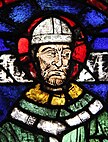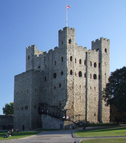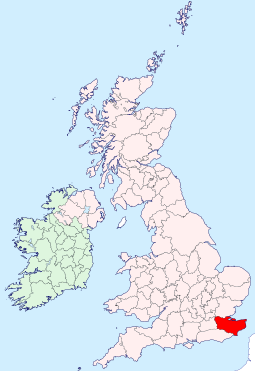
A | B | C | D | E | F | G | H | CH | I | J | K | L | M | N | O | P | Q | R | S | T | U | V | W | X | Y | Z | 0 | 1 | 2 | 3 | 4 | 5 | 6 | 7 | 8 | 9
Kent | |
|---|---|
The White Cliffs of Dover, stained glass depicting Thomas Becket in Canterbury Cathedral, and Rochester Castle | |
| Coordinates: 51°12′N 0°42′E / 51.200°N 0.700°E | |
| Sovereign state | United Kingdom |
| Constituent country | England |
| Region | South East |
| Established | Ancient |
| Time zone | UTC+0 (GMT) |
| • Summer (DST) | UTC+1 (BST) |
| UK Parliament | List of MPs |
| Police | Kent Police |
| Ceremonial county | |
| Lord Lieutenant | Annabel Campbell |
| High Sheriff | Mrs Remony Millwater[1] (2020/21) |
| Area | 3,738 km2 (1,443 sq mi) |
| • Rank | 10th of 48 |
| Population (2022)[2] | 1,875,893 |
| • Rank | 7th of 48 |
| Density | 502/km2 (1,300/sq mi) |
| Ethnicity | 93.7% White (89.1% White British)[3] |
| Non-metropolitan county | |
| County council | Kent County Council |
| Executive | Conservative |
| Admin HQ | Maidstone |
| Area | 3,544 km2 (1,368 sq mi) |
| • Rank | 6th of 21 |
| Population (2022)[2] | 1,593,191 |
| • Rank | 1st of 21 |
| Density | 449/km2 (1,160/sq mi) |
| ISO 3166-2 | GB-KEN |
| GSS code | E10000016 |
| ITL | UKJ42 |
| Website | kent |
| Districts | |
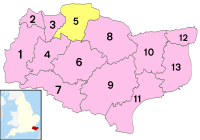 Districts of Kent Unitary County council area | |
| Districts | |
Kent is a county in the South East England region, the closest county to continental Europe. It borders Essex across the entire estuary of the River Thames to the north; the French department of Pas-de-Calais across the Strait of Dover to the south-east; East Sussex to the south-west; Surrey to the west and Greater London to the north-west. The county town is Maidstone.
It is the fifth most populous county in England, the most populous non-metropolitan county and the most populous of the Home Counties, an area influenced by the capital such as commutes and transport connections to the capital. Twenty-eight per cent of the county forms part of two Areas of Outstanding Natural Beauty: the North Downs and The High Weald.
Kent was one of the first British territories to be settled by Germanic tribes, most notably the Jutes, following the withdrawal of the Romans.[4] Canterbury Cathedral in Kent, the oldest cathedral in England, has been the seat of the Archbishops of Canterbury since the conversion of England to Christianity that began in the 6th century with Saint Augustine. Rochester Cathedral in Medway is England's second-oldest cathedral. Located between London and the Strait of Dover, which separates England from mainland Europe, Kent has been the setting for both conflict and diplomacy, including the Battle of Britain in World War II and the Leeds Castle peace talks of 1978 and 2004.
England relied on the county's ports to provide warships through much of its history; the Cinque Ports in the 10th[5]–14th centuries and Chatham Dockyard in the 16th–20th centuries were of particular importance. France can be seen clearly in fine weather from Folkestone and the White Cliffs of Dover. Hills in the form of the North Downs and the Greensand Ridge span the length of the county and in the Vale of Holmesdale in between and to the south are most of the county's 26 castles.
The county has agriculture, haulage, logistics and tourism industries. As the land between the capital and the wider continent, it is a high-income county. Agriculture of the county is a notable sector: "The Garden of England" is a nickname for the county, which has multiple orchards and allotments.[6] In north-west Kent, industries include aggregate building material extraction, printing and scientific research. Coal mining has also played its part in the county's industrial heritage.
Etymology

The name Kent is believed to be of Celtic origin. The meaning has been explained as 'coastal district,' 'corner-land' or 'land on the edge' (compare Welsh cant 'bordering of a circle, tyre, edge;' Breton cant 'circle;' Dutch kant 'side, edge'). In Latin sources the area is called Cantia or Cantium, while the Anglo-Saxons referred to it as Cent, Cent lond or Centrice.[7][8]
History
The area was first occupied by early humans, intermittently due to periods of extreme cold, during the Palaeolithic (Old Stone Age), as attested by an early Neanderthal skull found in the quarries at Swanscombe. The Medway megaliths were built during the Neolithic era. There is a rich sequence of Bronze Age, Celtic Iron Age, and Britto-Roman era occupation, as indicated by finds and features such as the Ringlemere gold cup and the Roman villas of the Darent valley.[9]
Julius Caesar described the area as Cantium, or the home of the Cantiaci, in 51 BC.[10] The extreme west of the modern county was by the time of Roman Britain occupied by a Celtic Iron Age tribe known as the Regni. Caesar wrote that the people of Kent were 'by far the most civilised inhabitants of Britain'.[8]
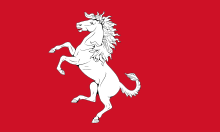
Following the withdrawal of the Romans, large numbers of Germanic speakers from mainland Europe settled in Kent, bringing their language, which came to be Old English. While they expelled the native Romano-British population, some likely remained in the area, eventually assimilating with the newcomers.[11] Of the invading tribes, the Jutes were the most prominent, and the area became a Jutish kingdom[12] recorded as Cantia in about 730 and Cent in 835. The early medieval inhabitants of the county were referred to as the Cantwara, or Kentish people. The city of Canterbury was the largest in Kent.[13]
In 597, Pope Gregory I appointed the religious missionary (who became Saint Augustine of Canterbury after his death) as the first Archbishop of Canterbury. In the previous year, Augustine successfully converted the pagan King Æthelberht of Kent to Christianity. The Diocese of Canterbury became England's first Episcopal See with first cathedral and has since remained England's centre of Christianity.[14] The second designated English cathedral was for West Kent at Rochester Cathedral.[15]
Kent was traditionally partitioned into East and West Kent, and into lathes and hundreds. The traditional border of East and West Kent was the county's main river, the Medway. Men and women from east of the Medway are Men (or Maids) of Kent, those from the west are Kentishmen or Kentish Maids.[8] The divide has been explained by some as originating in the Anglo-Saxon migrations, with Jutes mainly settling east of the Medway and Saxons settling west of it.[16][17]
In the 11th century, the people of Kent (or Chenth, per the Domesday Book) adopted the motto Invicta, meaning "undefeated" or "unconquered". The adoption of this motto followed the invasion of Britain by William of Normandy, as he was unable to subdue the county and they negotiated favourable terms. The continued resistance of the Kentish people against the Normans led to Kent's designation as a semi-autonomous county palatine in 1067. Under the nominal rule of William's half-brother Odo of Bayeux, the county was granted similar powers to those granted in the areas bordering Wales and Scotland.[18]
During the medieval and early modern period, Kent played a major role in several of England's most notable rebellions, including the Peasants' Revolt of 1381, led by Wat Tyler,[19] Jack Cade's Kent rebellion of 1450, and Wyatt's Rebellion of 1554 against Queen Mary I.[20]

The Royal Navy first used the River Medway in 1547. By the reign of Elizabeth I (1558–1603) a small dockyard had been established at Chatham. By 1618, storehouses, a ropewalk, a drydock, and houses for officials had been built downstream from Chatham.[21]

By the 17th century, tensions between Britain and the powers of the Netherlands and France led to increasing military build-up in the county. Forts were built all along the coast following the raid on the Medway, a successful attack by the Dutch navy on the shipyards of the Medway towns in 1667.[22]
The 18th century was dominated by wars with France, during which the Medway became the primary base for a fleet that could act along the Dutch and French coasts. When the theatre of operation moved to the Atlantic, this role was assumed by Portsmouth and Plymouth, with Chatham concentrating on shipbuilding and ship repair. As an indication of the area's military importance, the first Ordnance Survey map ever drawn was a one-inch map of Kent, published in 1801.[23] Many of the Georgian naval buildings still stand.
In the early 19th century, smugglers were very active on the Kent coastline. Gangs such as The Aldington Gang brought spirits, tobacco and salt to the county, and transported goods such as wool across the sea to France.[24]
In 1889, the County of London was created and took over responsibility for local administration of parts of north-west Kent. These included the towns of Greenwich, Woolwich, Deptford, Lee, Eltham, Charlton, and Kidbrooke. In 1900, however, Kent absorbed the district of Penge. Some of Kent is contiguous with the Greater London sprawl, notably parts of Dartford.
Originally, the border between Kent and Sussex (later East Sussex) ran through the towns of Tunbridge Wells and Lamberhurst. In 1894, by the Local Government Act, the parts of these towns that lay in East Sussex were absorbed by Kent.
During the Second World War, much of the Battle of Britain was fought in the skies over Kent.
Between June 1944 and March 1945, more than 10,000 V1 flying bombs, or "Doodlebugs", were fired towards London from bases in Northern France. Although many were destroyed by aircraft, anti-aircraft guns and barrage balloons, both London and Kent were hit by around 2,500 of these bombs.
After the war, Kent's borders changed several more times. In 1965, the London boroughs of Bromley and Bexley were created from nine towns formerly in Kent.[25][26] In 1998, Rochester, Chatham, Gillingham and Rainham left the administrative county of Kent to form the Unitary Authority of Medway. Plans for another unitary authority in north-west Kent were dropped, but in 2016 consultations began between five Kent local authorities (Canterbury, Thanet, Dover, Folkestone & Hythe, and Ashford) with a view to forming a new unified authority for East Kent, although remaining within the auspices of Kent County Council. This idea was eventually dropped.
For almost nine centuries, a small part of present-day East London (the North Woolwich, London E16 area), formed part of Kent.
Geography



Kent is in the southeastern corner of England. It borders the Thames Estuary and the North Sea to the north, and the Straits of Dover and the English Channel to the south. France is 21 miles (34 km) across the Strait.[27]
The major geographical features of the county are based on a series of ridges and valleys running east–west across the county. These are the results of erosion of the Wealden dome, a dome across Kent and Sussex created by alpine movements 20–10 million years ago. This dome consists of an upper layer of chalk above successive layers of Upper Greensand, Gault Clay, Lower Greensand, Weald Clay, and Wealden sandstone. The ridges and valleys formed when the exposed clay eroded faster than the exposed chalk, greensand, or sandstone.
Sevenoaks, Maidstone, Ashford, and Folkestone are built on greensand,[28] while Tonbridge and Tunbridge Wells are built on sandstone.[29] Dartford, Gravesend, the Medway towns, Sittingbourne, Faversham, Canterbury, Deal, and Dover are built on chalk.[28][29] The easterly section of the Wealden dome has been eroded away by the sea, and cliffs such as the White Cliffs of Dover are present where a chalk ridge known as the North Downs meets the coast. Spanning Dover and Westerham is the Kent Downs Area of Outstanding Natural Beauty.[30]
The Wealden dome is a Mesozoic structure lying on a Palaeozoic foundation, which can often create the right conditions for coal formation. This is found in East Kent roughly between Deal, Canterbury, and Dover. The Coal Measures within the Westphalian Sandstone are about 820–1,310 ft (250–400 m) deep, and are subject to flooding. They occur in two major troughs, which extend under the English Channel.[31]
Seismic activity has occasionally been recorded in Kent, though the epicentres were offshore. In 1382 and 1580 there were two earthquakes exceeding 6.0 on the Richter Scale. In 1776, 1950, and on 28 April 2007 there were earthquakes of around 4.3. The 2007 earthquake caused physical damage in Folkestone.[32] A further quake on 22 May 2015 measured 4.2 on the Richter Scale.[33] It was centred in the Sandwich area of east Kent at about ten miles below the surface. There was little if any damage reported.
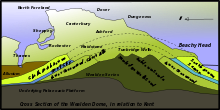
The coastline of Kent is continuously changing, due to tectonic uplift and coastal erosion. Until about 960, the Isle of Thanet was an island, separated by the Wantsum channel, formed around a deposit of chalk; over time, the channels silted up with alluvium. Similarly Romney Marsh and Dungeness have been formed by accumulation of alluvium.[29]
Kent's principal river, the River Medway, rises near East Grinstead in Sussex and flows eastwards to Maidstone. Here it turns north and breaks through the North Downs at Rochester, then joins the estuary of the River Thames near Sheerness. The Medway is some 70 miles (112 km) long.[34][35] The river is tidal as far as Allington lock, but in earlier times, cargo-carrying vessels reached as far upstream as Tonbridge.[34] The Medway has captured the head waters of other rivers such as the River Darent. Other rivers of Kent include the River Stour in the east.
A 2014 study found that Kent shares significant reserves of shale oil with other neighbouring counties, totalling 4.4 billion barrels of oil, which then Business and Energy Minister Michael Fallon said "will bring jobs and business opportunities" and significantly help with UK energy self-sufficiency. Fracking in the area is required to achieve these objectives; it has been opposed by environmental groups.[36]
Climate
Kent is one of the warmest parts of Britain. On 10 August 2003, in the hamlet of Brogdale near Faversham the temperature reached 38.5 °C (101.3 °F), at that time the highest temperature ever officially recorded in the United Kingdom. The record still stands as the hottest August day ever recorded.[37]
| Climate data for Wye, England (1981–2010) data | |||||||||||||
|---|---|---|---|---|---|---|---|---|---|---|---|---|---|
| Month | Jan | Feb | Mar | Apr | May | Jun | Jul | Aug | Sep | Oct | Nov | Dec | Year |
| Mean daily maximum °C (°F) | 7.4 (45.3) |
7.4 (45.3) |
10.3 (50.5) |
12.9 (55.2) |
16.3 (61.3) |
19.3 (66.7) |
21.8 (71.2) |
21.9 (71.4) |
18.8 (65.8) |
14.8 (58.6) |
10.7 (51.3) |
7.8 (46.0) |
14.1 (57.4) |
| Daily mean °C (°F) | 4.5 (40.1) |
4.4 (39.9) |
6.7 (44.1) |
8.7 (47.7) |
12.0 (53.6) |
14.7 (58.5) |
17.2 (63.0) |
17.2 (63.0) |
14.6 (58.3) |
11.2 (52.2) |
7.5 (45.5) |
5.0 (41.0) |
10.3 (50.5) |
| Mean daily minimum °C (°F) | 1.7 (35.1) |
1.5 (34.7) |
3.1 (37.6) |
4.6 (40.3) |
7.7 (45.9) |
10.2 (50.4) |
12.6 (54.7) |
12.5 (54.5) |
10.5 (50.9) |
7.7 (45.9) |
4.3 (39.7) |
2.3 (36.1) |
6.6 (43.9) |
| Average precipitation mm (inches) | 71.4 (2.81) |
50.3 (1.98) |
48.9 (1.93) |
49.1 (1.93) |
50.7 (2.00) |
48.8 (1.92) |
48.2 (1.90) |
61.8 (2.43) |
55.1 (2.17) |
93.0 (3.66) |
83.5 (3.29) |
80.3 (3.16) |
741.1 (29.18) |
| Average rainy days | 12.7 | 9.6 | 9.5 | 9.0 | 9.2 | 7.9 | 7.7 | 7.4 | 8.1 | 12.1 | 12.0 | 12.2 | 117.4 |
| Mean monthly sunshine hours | 59.6 | 79.6 | 115.3 | 174.1 | 205.2 | 200.1 | 213.7 | 210.3 | 152.2 | 118.2 | 71.9 | 49.8 | 1,649.9 |
| Source: [38] | |||||||||||||
Governance
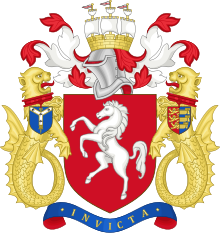
Kent County Council (KCC) and its 12 district councils administer most of the county (3352 km2), while the Medway Towns Council, a unitary authority and commonly called Medway Council, administers the more densely populated remainder (192 km2).[39] Together they have around 300 town and parish councils. Kent County Council's headquarters are in Maidstone,[40] while Medway's offices are at Gun Wharf, Chatham.
At the 2013 county council elections, control of Kent County Council was held by the Conservatives, who won 44 of the council's 83 seats. 17 seats were won by the United Kingdom Independence Party, 13 by the Labour Party, 7 by the Liberal Democrats, 1 by the Green Party and 1 by the Swanscombe and Greenhithe Residents Association. At the 2007 local elections[out of date], control of Medway Council was held by the Conservatives; 33 of the council's 55 seats were held by the Conservatives, 13 by the Labour Party, 8 by the Liberal Democrats and 1 by an Independent.[41] All but one of Kent's district councils are controlled by the Conservatives: a minority Labour administration took control of Thanet District in December 2011 after a Conservative councillor defected to the Independent group. In the council elections of May 2015 the United Kingdom Independence Party (UKIP) took control of the Council[which?], the first and so far only one in the UK. In October 2015 UKIP lost overall control following a series of resignations, although remaining the largest party, only for UKIP to regain control once more following ward elections in August 2016.
At the national level, Kent is represented in Parliament by 17 MPs, all of whom are Conservative except Rosie Duffield, Labour MP for Canterbury since 2017.
Demography
At the 2011 census,[42] Kent, including Medway, had 1,727,665 residents (18.0% of which in Medway); had 711,847 households (17.5% of which in Medway) and had 743,436 dwellings (14.8% of which in Medway). 51.1% of Kent's population excluding Medway was female — as to Medway, this proportion was 50.4%.
The tables below provide statistics for the administrative county of Kent, that is, excluding Medway.
| Married couples with/without children | Sole occupants | Unmarried couples with/without children | Lone parents | Shared homes and institutions |
|---|---|---|---|---|
| 210,671 | 174,331 of which 79,310 over aged 65 | 63,750 | 60,645 | 77,877 |
| Unit | Claimants | Population (April 2011) | |
|---|---|---|---|
| August 2012 | August 2001 | ||
| Kent | 55,100 | 89,470 | 1,463,740 |
| % of 2011 Kent resident population (2001 population where applicable) |
3.8% | 6.7% | - |
| Three highest-ranking districts | |||
| Thanet | 6.5% | 11.3% | 134,186 |
| Folkestone and Hythe | 4.9% | 8.9% | 107,969 |
| Swale | 4.8% | 7.5% | 135,835 |
| Three lowest-ranking districts | |||
| Tonbridge and Malling | 2.5% | 4.4% | 120,805 |
| Sevenoaks | 2.3% | 4.3% | 114,893 |
| Tunbridge Wells | 2.2% | 5.1% | 115,049 |
Economy

At the 2001 UK census[out of date],[42] employment statistics for the residents in Kent, including Medway, were as follows: 41.1% in full-time employment, 12.4% in part-time employment, 9.1% self-employed, 2.9% unemployed, 2.3% students with jobs, 3.7% students without jobs, 12.3% retired, 7.3% looking after home or family, 4.3% permanently sick or disabled, and 2.7% economically inactive for other reasons. Of residents aged 16–74, 16% had a higher education qualification or the equivalent, compared to 20% nationwide.[42]
The average hours worked per week by residents of Kent were 43.1 for males and 30.9 for females. Their industry of employment was 17.3% retail, 12.4% manufacturing, 11.8% real estate, 10.3% health and social work, 8.9% construction, 8.2% transport and communications, 7.9% education, 6.0% public administration and defence, 5.6% finance, 4.8% other community and personal service activities, 4.1% hotels and restaurants, 1.6% agriculture, 0.8% energy and water supply, 0.2% mining, and 0.1% private households. This is higher than the whole of England for construction and transport/communications and lower for manufacturing.
Kent is sometimes known as the "Garden of England" for its abundance of orchards and hop gardens. In particular the county produces tree-grown fruits,[43] strawberries and hazelnuts.[44] Distinctive hop-drying buildings called oasts are common in the countryside, although many have been converted into dwellings. Nearer to London, market gardens also flourish. Kent is the main area for hazelnut production in the UK.
However, in recent years, there has been a significant drop in agriculture, and industry and services are increasing their utilisation of the area. This is illustrated by the following table of economic indicator gross value added (GVA) between 1995 and 2003[out of date] (figures are in £ millions):[45]
| A Components may not sum to totals due to rounding |
| B includes energy and construction |
| C includes financial intermediation services indirectly measured |
North Kent is heavily industrialised, with cement-making at Northfleet and Cuxton, brickmaking at Sittingbourne, shipbuilding on the Medway and Swale, engineering and aircraft design and construction at Rochester, chemicals at Dartford, papermaking at Swanley, and oil refining at Grain.[25] There is a steel mini mill in Sheerness and a rolling mill in Queenborough. There are two nuclear power stations at Dungeness, although the older one, Dungeness A, built in 1965, was decommissioned in 2006.[46]
Cement-making, papermaking, and coal-mining were important industries in Kent during the 19th and 20th centuries. Cement came to the fore in the 19th century when massive building projects were undertaken. The ready supply of chalk and huge pits between Stone and Gravesend bear testament to that industry. There were also other workings around Burham on the tidal Medway.[47] Chalk, gravel and clay were excavated on Dartford Heath for centuries.
Kent's original paper mills stood on streams like the River Darent, tributaries of the River Medway, and on the River Stour. Two 18th century mills were on the River Len and at Tovil on the River Loose. In the late 19th century huge modern mills were built at Dartford and Northfleet on the River Thames and at Kemsley on The Swale. In pre-industrial times, almost every village and town had its own windmill or watermill, with over 400 windmills known to have stood at some time. Twenty-eight survive within the county today, plus two replica mills and a further two in that part of Kent now absorbed into London. All the major rivers in the county were used to power watermills.
From about 1900, several coal pits operated in East Kent. The Kent Coalfield was mined during the 20th century at several collieries,[48] including Chislet, Tilmanstone, Betteshanger, and the Snowdown Colliery, which ran from 1908 to 1986.[49]
The west of the county (including Tunbridge Wells, Tonbridge, and Sevenoaks) has less than 50% of the average claimant count for low incomes or worklessness as the coastal districts of Dover, Folkestone and Hythe, and Thanet (chiefly three resorts: Ramsgate, Broadstairs, and Margate). West and Central Kent have long had many City of London commuters.
Culture
Architecture
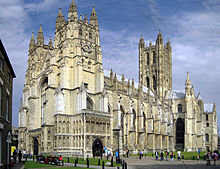
Kent's geographical location between the Straits of Dover and London has influenced its architecture, as has its Cretaceous geology and its good farming land and fine building clays. Kent's countryside pattern was determined by a gavelkind inheritance system that generated a proliferation of small settlements. There was no open-field system, and the large tracts were owned by the two great abbeys, Christ Church, Canterbury and St Augustine's Abbey, that did not pass into the hands of the king during the Reformation. Canterbury Cathedral is the United Kingdom's metropolitan cathedral; it was founded in AD 598 and displays architecture from all periods. There are nine Anglo-Saxon churches in Kent. Rochester Cathedral is England's second-oldest cathedral, the present building built in the Early English Style.[50] These two dioceses ensured that every village had a parish church.
The sites of Richborough Castle and Dover Castle, along with two strategic sites along Watling Street, were fortified by the Romans and the Dukes of Kent. Other important sites include Canterbury city walls and Rochester Castle.[51] There remained a need to defend London and thus Kent. Deal Castle, Walmer Castle, Sandown Castle (whose remains were eroded by the sea in the 1990s) were constructed in late mediaeval times, and HM Dockyard, at Chatham and its surrounding castles and forts—Upnor Castle, Great Lines, and Fort Amherst—more recently.
Kent has three unique vernacular architecture forms: the oast house, the Wealden hall house, and Kentish peg-tiles.
Kent has bridge trusts to maintain its bridges, and though the great bridge (1387) at Rochester was replaced there are medieval structures at Aylesford, Yalding and Teston.[52] With the motorways in the late twentieth century came the M2 motorway bridge spanning the Medway and the Dartford tunnel and the Dartford Bridge spanning the Thames.
Literature and publishing
Kent has provided inspiration for several notable writers and artists. Canterbury's religious role gave rise to Chaucer's Canterbury Tales, a key development in the English language. The father of novelist Charles Dickens worked at the Chatham Dockyard; in many of his books, the celebrated novelist featured the scenery of Chatham, Rochester, and the Cliffe marshes.[53] During the late 1930s, Nobel Prize-awarded novelist William Golding worked as a teacher at Maidstone Grammar School, where he met his future wife Ann Brookfield.[54] William Caxton, who first introduced the printing press to England, was born in Kent; the recent invention was key in helping many Kent dialect words and spellings to become standard in English. Lord Northbourne hosted a biodynamic agriculture conference on his estate at Betteshanger in the summer of 1939, he coined the term 'organic farming' and published his manifesto of organic agriculture the following year spawning a global movement for sustainable agriculture and food.[55]
Classical music
Many notable musicians have been associated with Kent.[56] Walter Galpin Alcock, composer and organist, who played the organ at the coronations of Edward VII, George V and George VI, was born at Edenbridge in 1861. Richard Rodney Bennett, composer and pianist, was born at Broadstairs in 1936. Alfred Deller, counter-tenor singer, was born at Margate in 1912. Orlando Gibbons, composer and organist, died in Canterbury on 5 June 1625 and is buried in the cathedral. George Frideric Handel took the waters at Royal Tunbridge Wells in 1734 and 1735. Wolfgang Amadeus Mozart, together with his father, mother and sister, stayed at Bourne Park House near Canterbury, 25-30 July 1765. The nights of 24 and 30 July were spent in Canterbury, where they also went to the horse races. Nikolai Rimsky-Korsakov, then an 18-year-old sea cadet, was anchored at Gravesend from November 1862 to February 1863; while there, he completed the slow movement of his First Symphony. Malcolm Sargent, conductor, was born at Ashford in 1895. Thomas Tallis, composer and organist, was a lay clerk of Canterbury Cathedral around 1541-2. Peter Warlock, composer and writer on music, and Ernest John Moeran, composer, resided at Eynsford from 1925 to 1928; Arnold Bax, William Walton and Constant Lambert visited them here. Percy Whitlock, organist and composer, was born at Chatham in 1903.
Visual arts
A number of significant artists came from Kent, including Thomas Sidney Cooper, a painter of landscapes, often incorporating farm animals,[57] Richard Dadd, a maker of faery paintings, and Mary Tourtel, the creator of the children's book character, Rupert Bear. The artist Clive Head was also born in Kent. The landscape painter J. M. W. Turner spent part of his childhood in the town of Margate in East Kent, and regularly returned to visit it throughout his life. The East Kent coast inspired many of his works, including some of his most famous seascapes.[58] Kent has also been the home to artists including Frank Auerbach, Tracey Emin and Stass Paraskos.
Kent was also the location of the largest number of art schools in the country during the nineteenth century, estimated by the art historian David Haste, to approach two hundred. This is believed to be the result of Kent being a front line county during the Napoleonic Wars. At this time, before the invention of photography, draughtsmen were used to draw maps and topographical representations of the fields of battle, and after the wars ended many of these settled permanently in the county in which they had been based. Once the idea of art schools had been established, even in small towns in Kent, the tradition continued, although most of the schools were very small one-man operations, each teaching a small number of daughters of the upper classes how to draw and make watercolour paintings. Nonetheless, some of these small art schools developed into much larger organisations, including Canterbury College of Art, founded by Thomas Sidney Cooper in 1868, which is today the University for the Creative Arts.[59]
Blean near Canterbury was home to Smallfilms, the production company founded by Oliver Postgate and Peter Firmin and responsible for children's TV favourites Noggin the Nog, Ivor the Engine and Bagpuss.
Performing arts
The county's largest theatre is the Marlowe Theatre in the centre of Canterbury.[60]
Music festivals that take place in Kent include Chilled in a Field Festival, Electric Gardens, Hop Farm Festival, In the Woods Festival, Lounge On The Farm and the annual Smugglers Festival near Deal. Other venues for live music include Leas Cliff Hall in Folkestone and the Assembly Hall in Tunbridge Wells.
Zdroj:https://en.wikipedia.org?pojem=Kent,_England
Text je dostupný za podmienok Creative Commons Attribution/Share-Alike License 3.0 Unported; prípadne za ďalších podmienok. Podrobnejšie informácie nájdete na stránke Podmienky použitia.
Antropológia
Aplikované vedy
Bibliometria
Dejiny vedy
Encyklopédie
Filozofia vedy
Forenzné vedy
Humanitné vedy
Knižničná veda
Kryogenika
Kryptológia
Kulturológia
Literárna veda
Medzidisciplinárne oblasti
Metódy kvantitatívnej analýzy
Metavedy
Metodika
Text je dostupný za podmienok Creative
Commons Attribution/Share-Alike License 3.0 Unported; prípadne za ďalších
podmienok.
Podrobnejšie informácie nájdete na stránke Podmienky
použitia.
www.astronomia.sk | www.biologia.sk | www.botanika.sk | www.dejiny.sk | www.economy.sk | www.elektrotechnika.sk | www.estetika.sk | www.farmakologia.sk | www.filozofia.sk | Fyzika | www.futurologia.sk | www.genetika.sk | www.chemia.sk | www.lingvistika.sk | www.politologia.sk | www.psychologia.sk | www.sexuologia.sk | www.sociologia.sk | www.veda.sk I www.zoologia.sk


